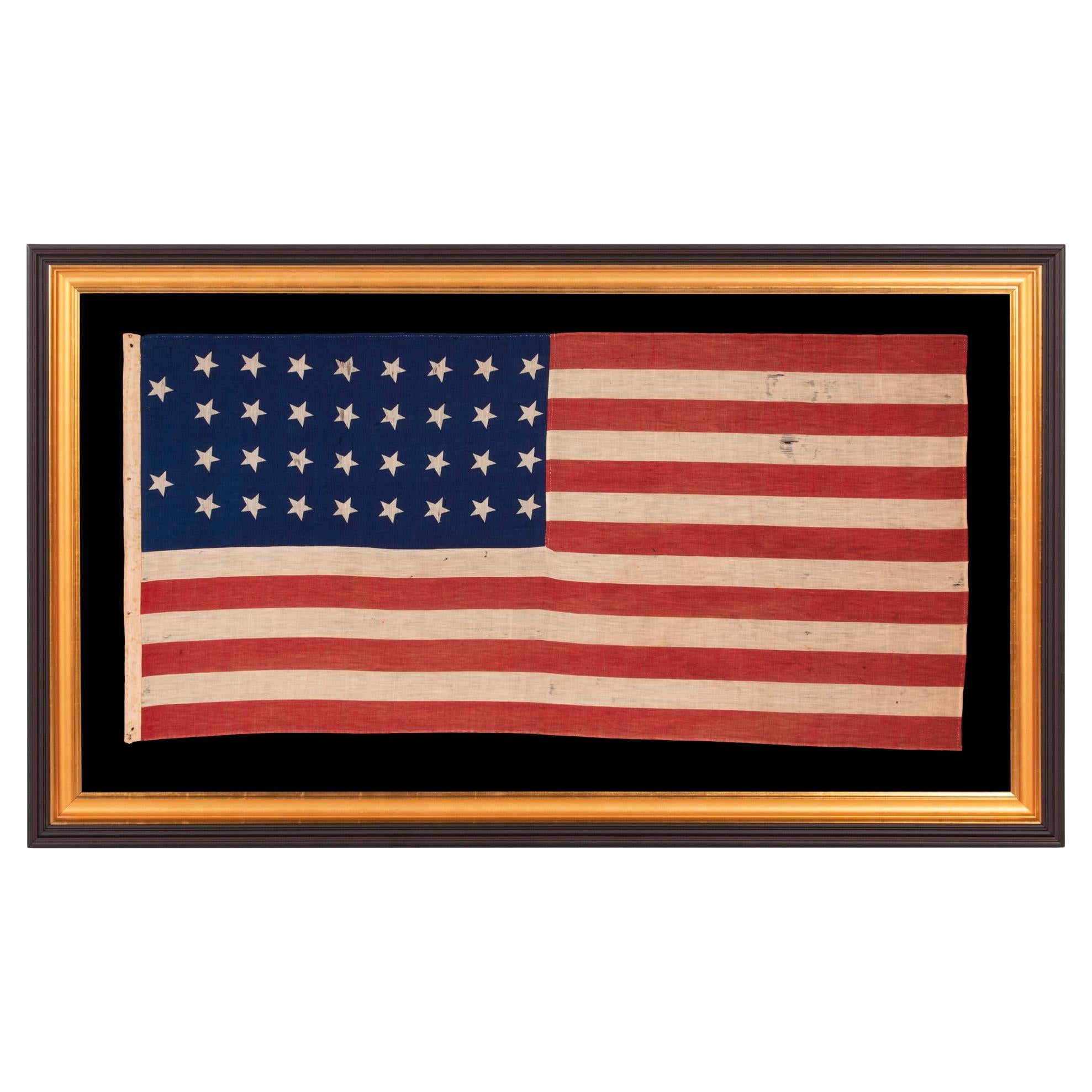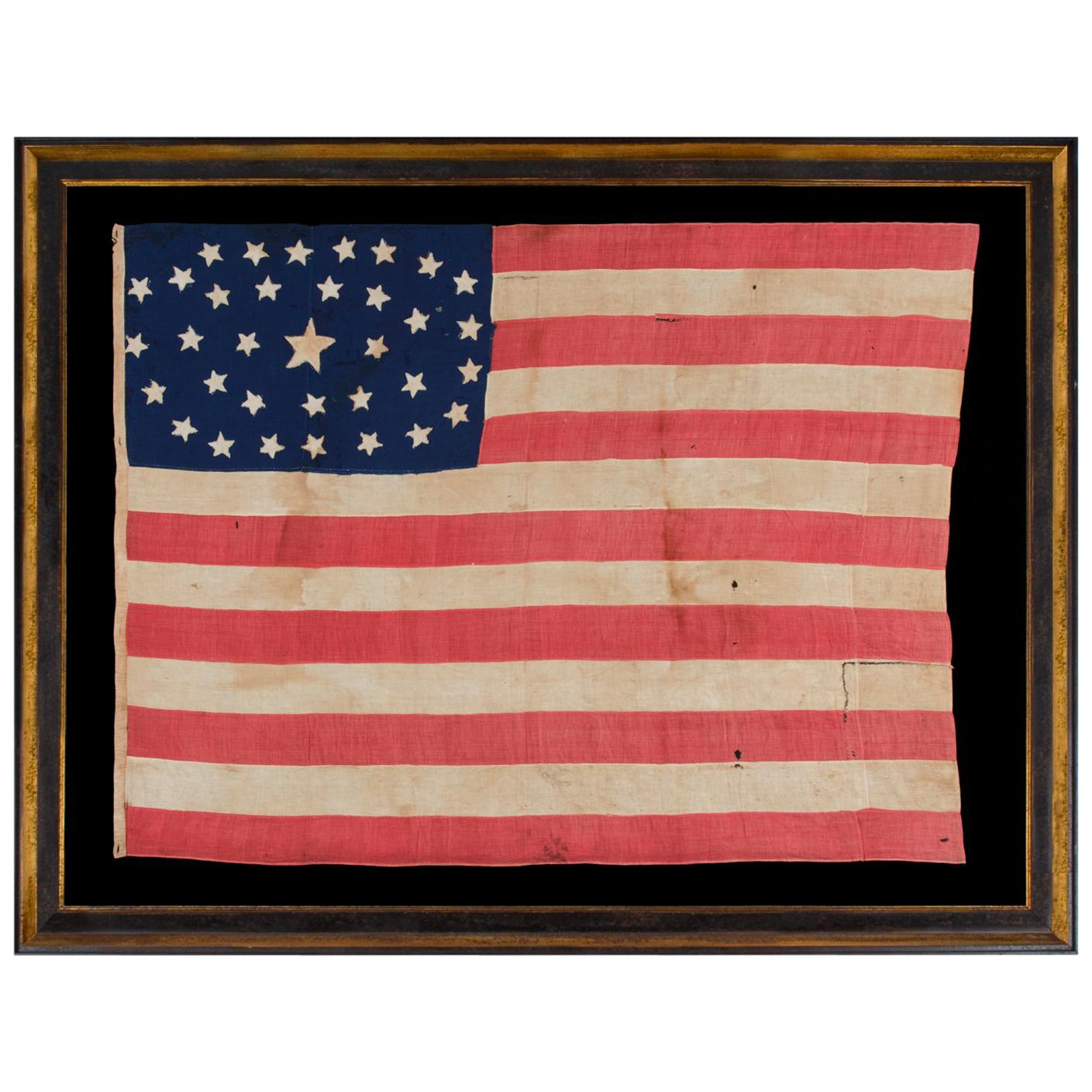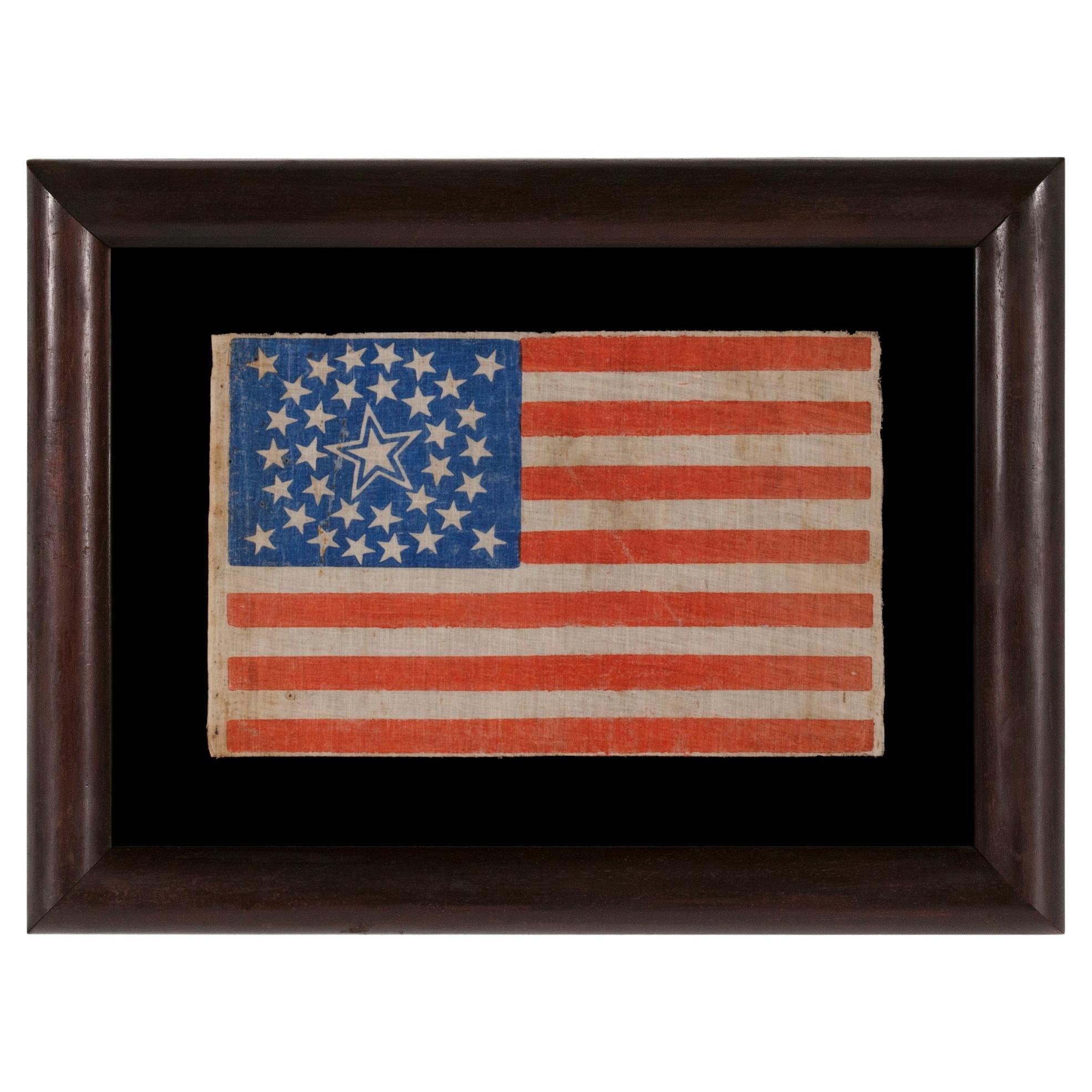Items Similar to 34 TUMBLING STARS on an ANTIQUE AMERICAN FLAG, CIVIL WAR PERIOD, 1861-63, KANSAS
Want more images or videos?
Request additional images or videos from the seller
1 of 8
34 TUMBLING STARS on an ANTIQUE AMERICAN FLAG, CIVIL WAR PERIOD, 1861-63, KANSAS
About the Item
34 STARS WITH "DANCING" OR "TUMBLING" ORIENTATION, ON AN ANTIQUE AMERICAN FLAG WITH EXTRAORDINARY COLORS, PRESS-DYED ON WOOL BUNTING, LIKELY PRODUCED FOR USE AS MILITARY CAMP COLORS, CIVIL WAR PERIOD, 1861-1863, REFLECTS THE ADDITION OF KANSAS TO THE UNION AS A FREE STATE:
34 star American national flag, press-dyed on wool bunting, with beautiful colors and interesting visual features. Note how the stars, which are arranged in linear rows of 7-7-6-7-7, are oriented consecutively point-up, point down in their vertical alignment across the canton, resulting in what I call “tumbling” or “dancing” formation. Also note how the shade of cornflower blue exhibits interesting, periwinkle blue overtones, and how it contrasts with the deep, scarlet red. There is a hand-sewn, cotton binding along the hoist.
I believe that this extremely scarce style of 34 star flag, in this design, was sometimes sold to the Union Army, to be flown as flank markers or camp colors. Examples are known in both wool and silk, in the same style, with similar coloration. I owned an example of the same exact type, in silk, with overprinted text for a Pennsylvania volunteer regiment. Silk was light weight, and was the traditional fabric for land-use, military flags in the north. flags hand-carried by infantry and cavalry regiments in the North. Wool sheds water and was practical for long-term use in inclement weather.
It is likely that flags in this style, in both wool and silk, were simultaneously sold for whatever purpose the buyer wished. Some probably saw short-term use at parades and political events, as well as in service as props in commercial photography, for portraits of Civil War soldiers. Whatever the case may be, the size is excellent, being small enough to be easily framed and displayed, yet large enough to make a substantial impact, great for both serious collectors and one-time buyers alike.
Kansas was admitted into the Union as the 34th state on January 29th, 1861, about 2 ½ months before the Confederate assault on Fort Sumter that marked the beginning of the Civil War. The 34th star was officially added on July 4th of that year, but most flag makers would have added a 34th star at the time of Kansas’ arrival, if not even before that day—a practice that became common during the latter 19th century. This star count remained official until July 4th, 1863, and 34 star flags would have generally been produced until the addition of West Virginia in June of that year, 11 days before the Battle of Gettysburg.
Some Notes on the Press-Dying Process:
First patented in 1849, the press-dying process was thought to be a novel idea that would improve flag-making efficiency. In this case, for example, it could potentially alleviate the chore of hand-appliquéing 68 stars (34 on each side). In reality, however, the result must have been less efficient than sewing. To achieve white stars, for example, metal plates in the shape of stars had to be clamped to either side of a length of woolen fabric, in the desired configuration, so they were back-to-back. These may have been lightly brushed beforehand with a solution that would resist dye, or perhaps with a thin coat of wax. The stars were clamped together tightly, the bunting was dyed blue, and the areas where the metal stars were positioned would be left white. For flags with press-dyed stripes, the same task was repeated with different clamps.
A form of resist-dyeing, this method often resulted in crude characteristics, such as stripes with irregular lines, in various widths, and stars with inconsistent shapes, in slightly varying sizes. It is likely that this resulted in some lost product and wasted time, from flags that had bleeding or misprint issues and were of too poor quality to sell. Within those flags that survived, today’s collectors today find the irregularities interesting, not only because they demonstrate early production methods, but also because they lend the sort of folk qualities that make early flags more interesting to look at.
When compared to some other fabrics, printing on wool is costly and difficult. Even today, only about 1% of wool fabric is printed*, because it generally needs to be washed afterward and wool cannot easily be treated with water.
Mounting: The flag was mounted and framed within our own conservation department, which is led by expert staff. We take great care in the mounting and preservation of flags and have framed thousands of examples.
The background is 100% cotton twill, black in color, that has been washed and treated for colorfastness. The mount was placed in a substantial molding is dark brown in color, almost black, with reddish undertones and highlights, with a concave shape, a textured surface, and a rope-style inner lip. To this a flat profile molding, with a finish like old gunmetal, was added as a liner. The glazing is U.V. protective acrylic (Plexiglas).
Condition: There are two small areas of modest mothing and there is minor mothing elsewhere. There is moderate fading of the blue canton. There are two repairs along the hoist binding, at the top and bottom, where additional fabric was added for strength. Along the original part of the binding are light, penciled markings, now illegible. Many of my clients prefer early flags to show their age and history of use.
- Dimensions:Height: 34.25 in (87 cm)Width: 44.5 in (113.03 cm)Depth: 2.5 in (6.35 cm)
- Materials and Techniques:
- Place of Origin:
- Period:
- Date of Manufacture:1861-1863
- Condition:Wear consistent with age and use. See item description.
- Seller Location:York County, PA
- Reference Number:
About the Seller
5.0
Recognized Seller
These prestigious sellers are industry leaders and represent the highest echelon for item quality and design.
Established in 1991
1stDibs seller since 2008
61 sales on 1stDibs
Typical response time: 10 hours
- ShippingRetrieving quote...Ships From: York County, PA
- Return PolicyThis item cannot be returned.
More From This SellerView All
- 34 STAR AMERICAN FLAG, CIVIL WAR PERIOD, 1861-63, a RARE STYLE, KANSAS STATEHOODLocated in York County, PA34 STARS IN 4 ROWS WITH 2 STARS OFFSET AT THE HOIST END, ON AN ANTIQUE AMERICAN FLAG LIKELY PRODUCED FOR MILITARY FUNCTION, AS UNION ARMY CAMP COLORS; ONE OF JUST A TINY HANDFUL THAT I HAVE ENCOUNTERED IN THIS EXACT STYLE, REFLECTS KANSAS STATEHOOD, OPENING TWO YEARS OF THE CIVIL WAR...Category
Antique 1860s American Political and Patriotic Memorabilia
MaterialsWool, Cotton
- 34 Star Antique American flag, Kansas Statehood, Civil War Period, ca 1861-1863Located in York County, PA34 STAR ANTIQUE AMERICAN FLAG OF THE CIVIL WAR PERIOD (1861-63), WITH WOVEN STRIPES, PRESS-DYED STARS, AND BEAUTIFUL COLORS, POSSIBLY MADE IN NEW YORK BY THE ANNIN COMPANY, REFLECTS THE ADDITION OF KANSAS TO THE UNION, 1861-1863 34 star flag of the Civil War period, with a press-dyed canton and woven stripes. Made of a fabric produced frame a combination of wool and cotton fibers, the 34 star count was achieved in an unusual fashion, beginning with a press-dyed field of 32 star...Category
Antique 1860s American Political and Patriotic Memorabilia
MaterialsCotton
- 34 STAR AMERICAN FLAG, CIVIL WAR, 1861-63, KANSAS STATEHOOD, 2nd KY CAVALRYLocated in York County, PA34 STAR ANTIQUE AMERICAN FLAG OF THE CIVIL WAR PERIOD (1861-63), IN A TINY SCALE AMONG PIECED-AND-SEWN FLAGS OF THE PERIOD, WITH A TRIPLE-WREATH CONFIGURATION, AN ELONGATED FORMAT, AND ENTIRELY HAND-SEWN; FOUND WITH A LETTER FROM JOHN W. RUDE OF THE 2ND KENTUCKY VETERAN VOLUNTEER CAVALRY (UNION): 34 star flag of the Civil War period with a variety of extremely desirable features, handed down with a letter written by John W. Rude on November 8th, 1864, while encamped with the Army’s 1st Brigade, 3rd Division, as a member of the 2nd Regiment of Veteran Volunteer Cavalry. Tiny in scale among pieced and sewn examples, the flag displays a star pattern that consists of a three consecutive wreaths, with a single star in the very center. Because it lacks a single star in each corner, outside the basic pattern—usually present in flags of this design made during the mid-late 19th century—this is something I classify as a “snowball medallion.” Entirely hand-sewn throughout, note the square format of the blue canton, with its beautiful, circular star arrangement, and how interesting this combination is when paired with the elongated format of the flag itself. The stars are double-appliqued, meaning that they are applied to both sides. These are fat in shape and inconsistent in size. Note how the lowest star in the outermost ring actually dips into the white stripe below. Made of plain weave cotton, there is a narrow binding along the hoist, red in color, with three sets of cotton ties. Those at the top and bottom are made of fine, braided hemp or hemp and cotton cord, stitched into place, while the one in the center, looped around the binding and tied, is made of lightweight, twisted, cotton thread. Note how the 5th, 6th, and 7th red stripes are pieced from two lengths of cotton fabric, which reflects that the maker was being conscious of conserving available fabric. In the 19th century, most flags with pieced and sewn construction were 8 feet long and larger. A six-footer was considered small. Even military battle flags, carried on foot, measured 6’ x 6.5’, which translates into approximately 7’ x 7.5’ after framing, about the size of an average quilt and larger than can comfortably fit on a wall in a house with 8-foot ceilings and average width baseboard. Flags smaller than this exist, but the smaller they get, the more unusual they are. At just 1.5’ x 3’, this is about as small as one will ever encounter in a sewn flag of the Civil War era. The flag appears to have likely been hand-carried. I expect that it probably saw military use of some sort as a camp flag...Category
Antique 1860s American Political and Patriotic Memorabilia
MaterialsCotton
- 34 Stars in an Outstanding Oval Medallion Configuration, Civil War PeriodLocated in York County, PA34 STARS IN AN OUTSTANDING OVAL MEDALLION CONFIGURATION, ON A NARROW CANTON THAT RESTS ON THE 6TH STRIPE, ON A HOMEMADE, ANTIQUE AMERICAN FLAG OF THE CIVIL WAR PERIOD, ENTIRELY HAND-...Category
Antique 1860s American Political and Patriotic Memorabilia
MaterialsCotton
- 34 Star Antique American Parade Flag, Kansas Statehood, ca 1861-1863Located in York County, PA34 STARS IN A MEDALLION CONFIGURATION ON AN ANTIQUE AMERICAN PARADE FLAG WITH A LARGE, HALOED CENTER STAR; CIVIL WAR PERIOD, KANSAS STATEHOOD, 1861-1863 34 star American national pa...Category
Antique 1860s American Political and Patriotic Memorabilia
MaterialsCotton
- 34 Star Antique American Flag with Hourglass Medallion Stars, ca 1861-1863Located in York County, PAEXTRAORDINARY 34 STAR ANTIQUE AMERICAN FLAG WITH AN ACCORDION OR HOURGLASS MEDALLION CONFIGURATION THAT SURROUNDS A PENTAGON OF STARS IN THE CENTER; MADE OF FINE SILK AND ENTIRELY HAND-SEWN; MADE DURING THE OPENING YEARS OF THE CIVIL WAR (1861-63), IN A TINY SIZE AMONG ITS COUNTERPARTS OF THE PERIOD; REFLECTS THE ADDITION OF KANSAS AS THE 34TH STATE 34 star flag of the Civil War period with an array of rare, beautiful, and otherwise desirable features. Extremely small among flags of this period with pieced and sewn construction, the flag displays a star pattern that is not only highly unusual, but unique to this particular example. This consists of a single star in the very center, surrounded by a pentagon of stars, flanked by angular bracket of three stars to either side. Above and below are rows of 5 stars, followed by rows of 6 that line the top and bottom of the canton. The resulting configuration is what I have termed an “accordion medallion,” though “hourglass medallion” or “standing bow tie” would be perfectly acceptable. When rotated 90 degrees, to view the harder-to-identify, bow tie formation, students of early star patterns may note the visual similarity between this and what I call “Starburst” or “Crosshatch” medallions. The pattern, however, conspicuously lacks the crosses of St. Andrew (a saltire) and St. George (roman cross), that would allow it to be more accurately categorized as such. Entirely hand-sewn, the canton and stripes of the flag are made of fine silk. The hemming of this was accomplished with great skill. The top and bottom edges are selvedge. These are so similar in nature as to have come from the same maker. There is a white, silk binding along the hoist, in the form of an open sleeve, through which a length of braided hemp rope was passed, expertly looped and re-braided into itself at the top and bottom for strength. The stars are made of white, polished cotton. These were stitched to both sides (double-appliqued). Note how the edges of the fabric were not turned under, providing evidence of the fact that the maker was not especially skilled in appliqueing. This was common, as applique work was far more difficult than producing French seams. In the 19th century, most flags with pieced and sewn construction were 8 feet long and larger. A six-footer was considered small. Even military battle flags, carried on foot, measured 6’ x 6.5’, which translates into approximately 7’ x 7.5’ after framing, about the size of an average quilt and larger than can comfortably fit on a wall in a house with 8-foot ceilings and average width baseboard. Flags smaller than this were produced both commercially and at home, but the smaller they are, the more unusual they are. At just 26.5 x 46.5 inches, this flag is extremely small for a Civil war period flag with sewn construction. Silk was both beautiful and lightweight, which made it elegant for military unit colors and preferable for flags meant to be carried on foot. Most outdoor use flags...Category
Antique 1860s American Political and Patriotic Memorabilia
MaterialsSilk
You May Also Like
- 34-Star Civil War American Flag, Antique Great Star Pattern, circa 1861Located in Colorado Springs, COThe stars of this extremely rare, Civil War-era flag are arranged in what is sometimes called the "Great Flower" pattern, a large star made out of smaller stars -- named as such beca...Category
Antique 1860s American Political and Patriotic Memorabilia
MaterialsLinen
- Early 20th C. Monumental American Flag with 48 Stars, c.1940-1950Located in San Francisco, CAAbout This is an original monumental American flag made with 48 hand sewn stars and stripes. It is in good condition and has brass grommets to hang. Creator unknown. Date of m...Category
Early 20th Century Industrial Political and Patriotic Memorabilia
MaterialsBrass
- Early 20th c. Monumental American Flag with 48 Stars, c.1940-1950Located in San Francisco, CAABOUT This is an original monumental American flag made by Valley Forge Co. with 48 hand sewn stars and stripes. It is in good condition and has metal grommets to hang. CREATO...Category
Early 20th Century Industrial Political and Patriotic Memorabilia
MaterialsFabric
- Large Vintage Wool American Flag with 48 Stars c.1940-1950-FREE SHIPPINGLocated in San Francisco, CAABOUT A large wool American flag made with 48 hand sewn stars and stripes. It is in good condition and has brass grommets to hang. CREATOR Unknown. DATE OF MANUFACTURE c.19...Category
Early 20th Century Industrial Political and Patriotic Memorabilia
MaterialsBrass
- Monumental "Valley Forge" American Flag with 48 Stars, c.1940-1950 (FREE SHIP)Located in San Francisco, CAAbout This is an original monumental American flag made by Valley Forge Co. with 48 stars and stripes and brass grommets. Creator Valley Forge Co. Date of manufacture c.1940-1950. ...Category
Early 20th Century Industrial Political and Patriotic Memorabilia
MaterialsBrass
- Large Vintage Valley Forge American Flag with 48 Stars c.1940-1950-FREE SHIPPINGLocated in San Francisco, CAABOUT A large Valley Forge American flag made with 48 hand sewn stars and stripes. It is in good condition and has brass grommets to hang. CREATOR Valley Forge. DATE OF MAN...Category
Early 20th Century Industrial Political and Patriotic Memorabilia
MaterialsBrass
Recently Viewed
View AllMore Ways To Browse
Sumter Furniture
Canton With Moths
West Point Memorabilia
Art And Politics
Gold Spanish Bullion
Loose Celebration Diamonds
Grand Duchess Tatiana
California Republic Flag Art
Civil War Cannon Balls
Circle Of Friends Medallion
Mason And Hamlin
Mormon Furniture
California Republic Vintage Flag
Hermes Folk Art Scarf
Hermes Scarf Folk
Nine Liberties
Antique Jewelry Lancaster Pa
Antique Metal Wash Stand Antiques





